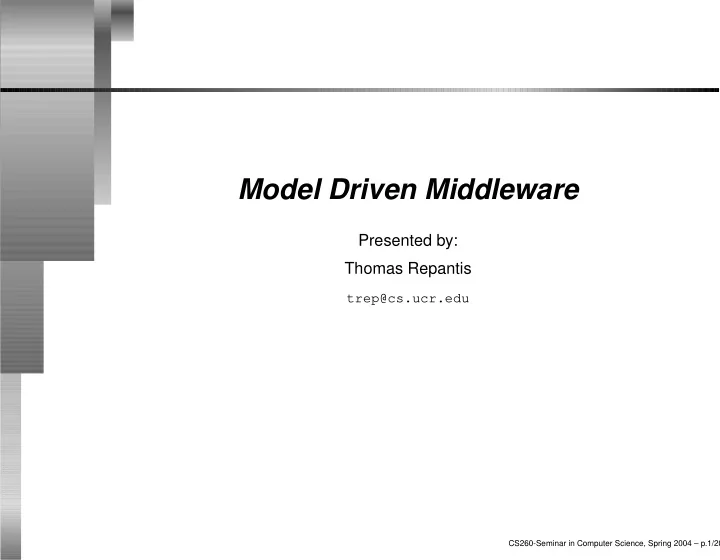

Model Driven Middleware Presented by: Thomas Repantis trep@cs.ucr.edu CS260-Seminar in Computer Science, Spring 2004 – p.1/20
Overview Applying Model Driven Architectures to Distributed Systems. 1. Distributed Real-Time Embedded Systems 2. Component Middleware 3. Model Driven Middleware 4. Existing Work on Real-Time MDM 5. Our Vision for Fault-Tolerant, Secure MDM CS260-Seminar in Computer Science, Spring 2004 – p.2/20
Distributed Real-Time Embedded (DRE) Systems Networks: • Large-scale • Heterogeneous • Dynamic CS260-Seminar in Computer Science, Spring 2004 – p.3/20
DRE Requirements • Real-time : • low latency, bounded jitter • Availability : • bounded fault propagation/recovery • Security : • authentication, authorization • Physical Requirements : • weight, power consumption, memory footprint CS260-Seminar in Computer Science, Spring 2004 – p.4/20
Component Middleware • Control of QoS properties • Platform independence • Cost reduction CS260-Seminar in Computer Science, Spring 2004 – p.5/20
Middleware Architectures • Real-time CORBA • Fault-tolerant CORBA CS260-Seminar in Computer Science, Spring 2004 – p.6/20
Unresolved Challenges • Isolation of applications from middleware platforms • Composing applications from components • Configuring component middleware • Automated deployment • Satisfying multiple QoS properties simultaneously Ad hoc (manual) techniques: • Do not scale well • Are tedious • Are error-prone • Lack verification and validation mechanisms CS260-Seminar in Computer Science, Spring 2004 – p.7/20
MDA to the rescue... MDA can express application functionality and QoS requirements at higher levels of abstraction than by using 3GLs: • Model properties • Analyze requirements • Synthesize code • Provision deployment CS260-Seminar in Computer Science, Spring 2004 – p.8/20
Model Driven Middleware Bridge the gap between specification and implementation: • Compose applications from reusable components. • Synthesize new extended components. • Automate the configuration of QoS aspects. • Model the interfaces of components in a standard way. • Easily handle changes in components. CS260-Seminar in Computer Science, Spring 2004 – p.9/20
MDM Example CS260-Seminar in Computer Science, Spring 2004 – p.10/20
Existing Work on Real-Time MDM Component Synthesis using Model Integrated Computing (CoSMIC - Douglas Schmidt - Vanderbilt University) CS260-Seminar in Computer Science, Spring 2004 – p.11/20
CoSMIC • Each CoSMIC tool synthesizes metadata in XML for use in the underlying middleware. • CoSMIC uses a Platform Specific Model to integrate the modeling technology with the CIAO QoS-enabled component middleware. CS260-Seminar in Computer Science, Spring 2004 – p.12/20
CoSMIC Details CoSMIC Modeling Paradigms: • OCML (Options Configuration Modeling Language) to model configuration parameters and constraints and synthesize the middleware configuration metadata. • CADML (Component Assembly and Deployment Modeling Language) to model component assembly and deployment. CS260-Seminar in Computer Science, Spring 2004 – p.13/20
Our Vision for Fault-Tolerant, Secure MDM Systems able to continue normal operation despite the presence of hardware or software faults: • Communication network failures • Node failures • Object failures Different security levels and domains: • Authentication • Authorization CS260-Seminar in Computer Science, Spring 2004 – p.14/20
Goals Fault-tolerance: • Automatic creation and allocation of replicas • Automatic maintenance of replica consistency • Automatic fault detection and recovery Security: • Automatic admission control • Automatic conformance to specific security levels CS260-Seminar in Computer Science, Spring 2004 – p.15/20
System Architecture • Replication Manager • Fault Detector • Admission Manager System Parameters: • Probability of failure for each component • Replication degree of each component • Security level satisfied by each component • Access privileges of each component CS260-Seminar in Computer Science, Spring 2004 – p.16/20
A Model-Driven Approach • Modeling of components • Configuration of parameters • Deployment • Fault-tolerance and security assurance CS260-Seminar in Computer Science, Spring 2004 – p.17/20
Conclusions • Distributed Real-Time Embedded Systems are increasingly being developed using component middleware. • Unresolved challenges include isolation of applications from the middleware platform, automatic application composition, and automatic middleware configuration. • Model Driven Architectures can provide a scalable and verifiable solution to the above. • Model Driven Middleware can automate the creation, configuration, and deployment of Real-Time, Fault-Tolerant, Secure distributed applications. CS260-Seminar in Computer Science, Spring 2004 – p.18/20
References 1. Aniruddha Gokhale, Douglas C. Schmidt, Balachandran Natarajan, Jeff Gray, and Nanbor Wang, “Model Driven Middleware”, Middleware for Communications, Wiley and Sons, 2003. 2. Aniruddha Gokhale et al., “ Model Driven Middleware: A New Paradigm for Deploying and Provisioning Distributed Real-time and Embedded Applications”, Elsevier Journal of Science of Computer Programming: Special Issue on Model Driven Architecture, 2004. 3. Aniruddha Gokhale et al., “CoSMIC: An MDA Generative Tool for Distributed Real-time and Embedded Applications”, Workshop on Model-driven Approaches to Middleware Applications Development at 4th IFIP/ACM/USENIX International Conference on Middleware for Distributed Systems Platforms, 2003. 4. The OMG Real-Time CORBA Specifi cation v1.1, 2002. 5. The OMG Fault Tolerant CORBA Specifi cation v1.0, 2000. 6. The OMG MDA Guide v1.0.1, 2003. CS260-Seminar in Computer Science, Spring 2004 – p.19/20
Thank you! Questions/Comments? CS260-Seminar in Computer Science, Spring 2004 – p.20/20
Recommend
More recommend